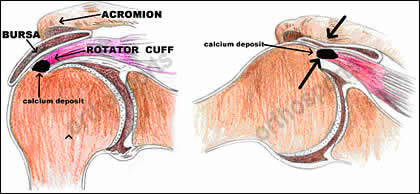Inside This section
Calcific Tendonitis
- To view a video of Calcific Tendonitis – Excision of Calcium and Acromioplasty, click here .
The Rotator Cuff is a group of tendons that attach to the shoulder. Occasionally deposits of calcium (a chalk-like substance) may form within the tendon, known as calcific tendonitis.
The cause of this condition is UNKNOWN. It usually occurs in people aged 30 to 40 years, and can occur in both shoulders in about 15% of people.
In over 90 percent of cases, the deposits disappear spontaneously, but this may take 12 to 18 months. Symptoms of pain can vary during this process. Some patients have very little pain, only occurring with movement of the arm, while others can have severe pain throughout the process.
Phases of Calcific Tendonitis
Normal Tendon | Formation of Calcium | Resting Period | Resorption Phase | Post Calcific to Normal |
No pain | No pain | Little pain | Severe pain | No pain |
0 months | 0-3 months | 3-9 months | 9-12 months | 12-18 months |
A small percentage of patients get acute, severe and unremitting pain. Fortunately, when these symptoms occur, it usually means that the calcium is in the resorption phase. The severe pain rarely lasts more than 72 hours.
Patients with these symptoms require immobilisation of the shoulder in a sling, regular analgesics, ice over the tender area and occasionally injections of cortisone. Very rarely is surgery required. If you have these symptoms you are advised to be patient as after the severe symptoms settle the residual mild symptoms rarely last more than 3 to 6 weeks.

Sometimes the calcium deposits can cause IMPINGEMENT. This is where the tendon is larger due to the calcium, and it rubs against the bone above. The irritation can cause inflammation known as bursitis. This is a painful condition, usually worsened with overhead activity and at night. Treatment for this condition involves anti-inflammatory tablets, physiotherapy, and occasionally cortisone injections. These symptoms usually will resolve when the calcium resorbs.
When the calcium deposits persist and symptoms do not resolve as expected, surgery is often necessary. Surgery involves an arthroscopic procedure. Tiny holes in the skin are made around the shoulder and instruments used to excise the calcium from the tendon and to shave the bony spur above the tendon to increase the space. Occasionally the tendon needs to be repaired due to the hole left behind once the calcium is removed.
After surgery, a sling is worn for about two weeks. Immediate motion is begun to avoid stiffness. Exercises are usually monitored by a physiotherapist. Exercises will vary depending upon the extent of the damage and need for repair of the tendon. The success of this surgery is 75%.
Remember…
- Calcium usually disappears spontaneously with time.
- Complete resolution of symptoms can take 12 to 18 months.
- The acute phase can be very painful but rarely lasts more than 72 hours
- If symptoms are severe or resolution slow, then surgery is considered.
